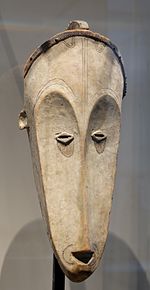芳人
| 芳人 | |
|---|---|
 4-faced Ngontang mask of Fang people | |
| 总人口 | |
| 约100万[1] | |
| 分布地区 | |
| 喀麦隆南部、赤道几内亚、加蓬北部、刚果部分地区 | |
| 语言 | |
| 芳语[2] | |
| 宗教信仰 | |
| 泛灵信仰、基督教 | |
| 相关族群 | |
| Beti people、Yaunde people |
芳人(Fang),非洲中西部民族,属于班图尼格罗人种,又称帕胡因人(Pahouin)、庞圭人、芳维人。主要分布在喀麦隆南部、赤道几内亚、加蓬北部以及刚果部分地区[1]。使用芳语,属于尼日尔-科尔多凡语系西北班图语群。使用拉丁字母拼写的文字。多信万物有灵,崇拜祖先、土地神和水神,部分人信基督教。共分 6 个部族、112 个部落 ,其中:埃翁多族有22个部落;贝内族有14个部落;布卢族有11个部落;恩图穆族有26个部落;姆韦族有13个部落;有26个部落。以父系氏族为基础,社会组织分为家庭、村庄、家族、氏族4级。实行一夫多妻制。主要种植木薯、芋头、玉米和芭蕉,兼事狩猎和采集。民间艺术与原始宗教信仰有密切关系,主要为造型艺术和面具雕刻等。村落中均有一座造型别致的公房,供全村用于开会议事、接待客人或娱乐活动。
民族分布、人口与语言
[编辑]芳人分布在喀麦隆南部(160万)、赤道几内亚(25万)、加蓬北部(35万)以及刚果部分地区,总人口大约为221万人。芳人使用芳语,其属于尼日尔-科尔多凡语系西北班图语群。而文字上使用拉丁字母拼写的文字[3]。
地理环境
[编辑]芳人分布的地区大多为炎热、潮湿的赤道雨林。
历史沿革
[编辑]18世纪末时芳人从萨纳加河右岸热带草原地区南迁至沿海雨林区。而后在19世纪末起先后遭受德国(1887)[4]、法国(1916)[5]的殖民统治。殖民统治结束后,在1960年起先后获得所在国的国家独立。[6]
社会、家庭、婚姻
[编辑]芳人为父系社会,其社会组织分为家庭、村庄、家族、氏族4级,组成方式为几个共同血统的家庭住在同一个村庄,而几个相近血统的村庄组成 一个家族(氏族)。其中氏族由酋长所领导,这位酋长拥有宗教权威。家族则是由年长者作为家族首领,在家族中无等级制度。村庄的领导者为世袭的,为建立起村庄的家庭成员后代担任。这种制度到现在领导者权力已变小,决策改由共识来决定。芳人实行一夫多妻制,在此制度下男女关系不平等,产生了他们友谊比爱情高贵的想法。[7]
产业与生活
[编辑]芳人的主食为木薯、芋头、玉米,而因为殖民地的背景种植巴蕉、可可、花生、棕榈等经济作物,拥有最密集的种植园[8],并兼事狩猎和采集。芳人没有固定的吃饭时间,食物的多寡是唯一限制,有东西就吃,吃到没有食物就停止。[9] 在殖民统治下对外贸易木头、象牙。 芳人的住宅为长方形茅屋,一般有两处,一处位于道路边并与道路平行、背对森林,另一处位于林间空地的农作物旁。而在村落里面有一个特别漂亮、宽敞的公房,供全村用于开会议事、接待客人、调解纠纷或从事娱乐活动。
信仰与习俗
[编辑]
芳人被认为是具有侵略性的勇士,在17世纪以前有吃人肉的习俗。芳人相信祖先的骨头含有和其在世时相同的能量,所以会将祖先的骨头放进木头盒子中保存。[10]在宗教上信奉泛灵信仰,他们崇拜祖先、土地神和水神,并会用巫术惩罚有罪之人[11],然而有部分人信奉基督教。
文学与艺术
[编辑]
芳人的艺术与原始宗教有密切关系,主要为造型艺术和面具雕刻,其面具使用为领导者戴上面具后能借此和祖先沟通,并也能用于狩猎仪式。现在这项技艺已渐渐没落,故传教士鼓励雕刻师做面具,把眼光看向新兴的观光业,面具便沦为观光市场的产品。[12][13]
跟当地其他族群相比,芳人更重视教育,文化层次普遍较高,多从事文职类工作,收入和社会地位也明显要高一些。
著名人士
[编辑]加蓬首任总统莱昂·姆巴为芳人。 赤道几内亚首任总统弗朗西斯科·马西亚斯·恩圭马是芳族。
参考资料
[编辑]- ^ 1.0 1.1 Anthony Appiah; Henry Louis Gates. Encyclopedia of Africa. Oxford University Press. 2010: 415–419, 460 [2017-03-17]. ISBN 978-0-19-533770-9. (原始内容存档于2017-03-23).
- ^ Fang (页面存档备份,存于互联网档案馆), Ethnologue
- ^ 世界民族博览社 (编). 世界民族博览. 北京:知识出版社. 1994年6月: 164. ISBN 7-5015-5601-6.
- ^ Beginning in 1887, German colonisers penetrated Beti-Pahuin territory to search for individuals to enslave on their coastal plantations Beti-Pahuin peoples Colonial period
- ^ French colonial rule of Cameroon began in 1916 and largely followed in the German mold. Beti-Pahuin peoples Colonial period
- ^ Since the end of the colonial period in the 1960s, the Beti-Pahuin have succeeded in making themselves politically important in both Cameroon and Equatorial Guinea. Beti-Pahuin peoples Post-independence
- ^ Of the Fang (Gaboon) it is said: “The marriage relation dominates all customs, and is the foundation of the whole social structure. With the African, love is not so closely linked with sex as among Western races. Friendship is deemed nobler than romantic love. This, of course, is due to the inequality of the sexes; a woman is not regarded as fit for companionship with men “Fetish Folk of West Africa”, p. 132
- ^ Most of these are Bulus or Fangs, since their territory contains the largest concentration of plantations. Beti-Pahuin peoples
- ^ The Fang have no regular time for eating; and when they have begun to eat there is no regular time for stopping. The quantity of food is the only limit. On a long journey they can go without food a very long time, far surpassing the endurance of a white man. And they are often compelled to travel with empty stomachs from their habit of eating all their food the first day.—“Fetish Folk of West Africa,” p. 117.
- ^ 存档副本. [2015-06-11]. (原始内容存档于2021-02-13).
- ^ A firm belief in witchcraft also persists among much of the population, and even today, sorcery is a punishable offense in some areas. Beti-Pahuin peoples
- ^ Today, however, very little of this traditional craft is still pursued, though missionary groups have encouraged some carvers to continue to practice with an eye toward the tourist market. Beti-Pahuin peoples
- ^ 存档副本. [2015-06-11]. (原始内容存档于2021-01-18).
